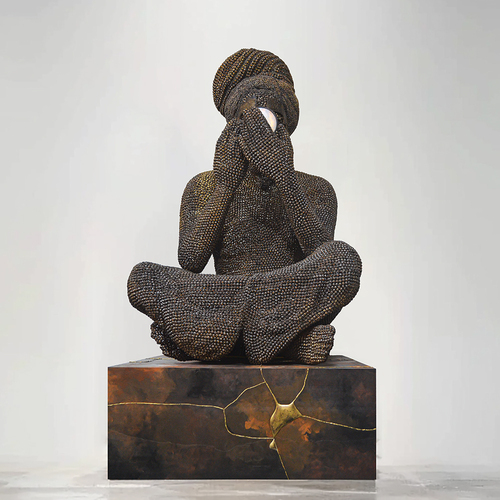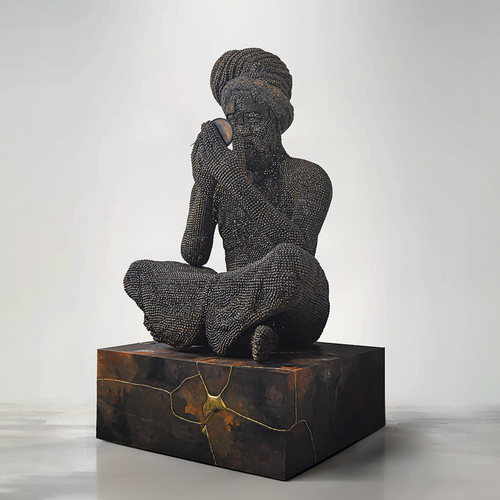AD Design Show, Mumbai 2025
Dvait: (the duality)
Artist Statement:
My work begins with a simple intention:I see, I honour, I make space.They are structure of my process and the ground of my work. These words guide how I look at the world and how I create.
“I see” means I want to choose every time to look at something — or someone — without filters, assumptions, or judgement. Not to correct it. Not to fix it. Just to truly see what is already there. It is an act of attention. It means; I want to slow down; I want to notice details. “I see” is my commitment to presence and honesty.
“I honour” means I want to acknowledge the value of what I’ve seen. I want to recognise its dignity. I want to give it importance through my actions. To honour is to say, your truth matters. Honouring transforms observation into respect.
“I make space” means I want to create room for what I’ve seen and honoured to breathe, grow, and exist without being limited. It means, I want to allow different identities, stories, and histories to coexist. I want to include voices beyond my own (through craft, collaboration, and culture) every time I create. I also invite viewers to enter the work with their own understanding.
I use mixed mediums to express myself; wood, paint, tiny metal elements all put together.
I use raw wood for its truthfulness. Wood carries its own story—Its grain, weight, and scars are not edited out—they are the first narrative of the piece. I don’t hide any of that. I let it stay as it is. It sharpens my ability to see without judgement and builds the foundation for everything that follows.
I use paint to honour what the wood reveals. Every stroke is intentional. Painting, for me, is an act of recognition—of form, emotion, and quiet detail. The paint becomes a precise way of turning attention into respect.
I integrate ghungroos, beads, and pipes—crafted by artisans whose skills carry generational lineage. These elements enter my work with its own quiet rhythm and include tradition, memory and craft. It reminds me that creation is not a solitary act; it is carried by many hands. These details open up space in the sculpture—for viewers to pause, for stories to enter, and for cultural memory and craftmanship to be seen and felt.
Through all these mediums; wood, paint, and tiny metal elements, I create work that is materially grounded, conceptually clear, and emotionally direct. I try to create work that feels honest and human—something that meets people gently, yet leaves them thinking long after.
My art is an invitation—but it is also a stance.
A stance for nuance, complexity, and dignity.
We live in a world that reduces people to categories—male/female, strong/soft, traditional/modern. My work rejects these shortcuts. Oversimplification erases real lives, real stories, real identities. By presenting figures and forms that don’t fit neatly into one box, I resist the pressure to choose a single narrative. Human identity is complex. Cultural memory is complex. The body is complex.
My art does not simplify this complexity to make it more digestible. Instead, it embraces it. My work asks viewers to sit with truths that don’t have easy answers. It allows contradictions, layers, and complexity to coexist. The subjects I engage with are not one thing; they are many things at once. My materials—raw wood, paint, tiny metal elements—also reflect this layered way of seeing. Nuance is not confusion; it is honesty.
Most importantly, my work insists on dignity. By seeing, honouring, and making space for subjects, I assert their right to exist fully—without disguise, without apology. Dignity is not decorative. It is the core of the work.


Artist: Richa
Artisans: Omveer, Rehman, Saddam, Waseem, Deep, Jagdish
Material: Mixed media
We embody dualities and they harmonize and make us realize that we can be both vulnerable and strong. This is the realization that we do not have to choose one side of ourselves—we are meant to exist in both worlds.
The sculpture draws inspiration from the sadhus at the Kumbh Mela. Their quiet confidence and unforced acceptance of themselves revealed something essential: wholeness is not an abstract idea; it is lived reality.
Wholeness is often spoken about as an idea: balance, harmony, oneness. Something abstract or philosophical. But in the context of my work, wholeness is something people actually live, whether or not society chooses to see it. It means a person is not divided inside themselves. Not forced to choose between being “masculine” or “feminine,” strong or gentle, logical or emotional. They simply exist as they are — with all their layers intact.
It means identity isn’t performed—it’s expressed.
The sadhus at the Kumbh Mela didn’t try to “represent” anything. They were whole because they had nothing to hide and nothing to prove. Their acceptance of themselves was not intellectual; it was embodied. It means complexity is carried with ease. People who are whole don’t struggle to fit into categories. They don’t divide parts of themselves to meet expectations. Their truth is not a theory — it is visible in how they walk, dress, speak, hold themselves, and exist in the world. It means the sacred and the ordinary meet in the body.
Wholeness is not an idea found in books or philosophies. It is found in gestures, breath, choices, presence. It is something you notice, not something you define. It means the work I create is not symbolic—it is real.
The figures I sculpt are not metaphors for balance. They are balance. They show that a human being can be multiple and still be complete. Wholeness is not something to think about —it is something you can witness, something you can feel,something you can live. It is the quiet power of someone who is fully themselves.
The base of the work serves as the conceptual ground. It represents a society (in wood) fractured, marked, undergoing change and undeniably moving forward (in paint). Drawing from the philosophy of kintsugi, the cracks are filled rather than concealed, suggesting that healing comes from acknowledgement, not erasure and gradually we are moving in that direction.
The sculpture above becomes the reason for that restoration—the catalyst who makes the cracks glow instead of collapse. It reflects a truth we have always known in philosophy, in temple sculptures, in the idea of Ardhanarishvara: duality is not division. It is lived reality. It embodies wholeness, duality, and acceptance — changes the meaning of those cracks.
Through its materials and through the hands of the artisans who shaped it, Dvait offers a vision of a world slowly learning to listen again, andto recognize the wholeness that has always been within us.
